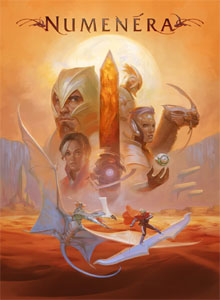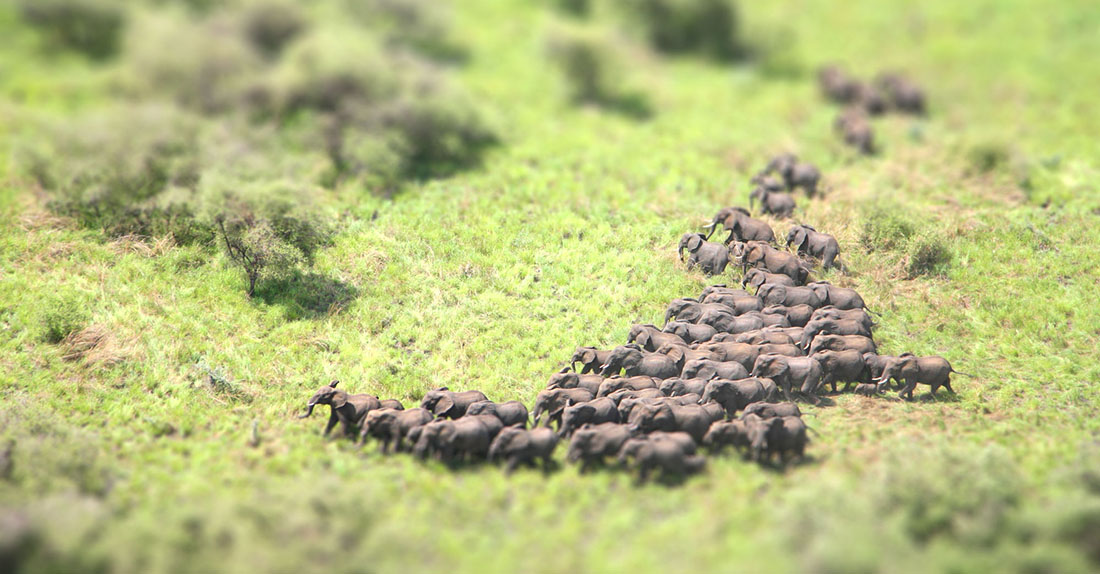 One of the tricks to running Numenera is to avoid falling back on your D&D-bred reflexes and having the game world default to a fantasy feeling. Although superficially similar to D&D fantasy due to its renaissance trappings, that’s not what the world of Numenera is: It’s a mélange of science fantasy on the far side of a billion years and eight mega-civilizations.
One of the tricks to running Numenera is to avoid falling back on your D&D-bred reflexes and having the game world default to a fantasy feeling. Although superficially similar to D&D fantasy due to its renaissance trappings, that’s not what the world of Numenera is: It’s a mélange of science fantasy on the far side of a billion years and eight mega-civilizations.
Keeping that in mind is the inspiration behind this techno-weird tavern. Whether you use it as a respite between adventures, a pit stop on a long and dusty road, or as an introductory mini-scenario to orient your players to the nature of Numenera, you’ll hopefully find it suffused with the unique flavor of the Ninth World.
(You could also take the various bar games and activities and split them up into multiple taverns, each with its own particular focus.)
GETTING A TABLE
The place is crowded, but it shouldn’t be too difficult to cadge a table near the center of the modular, multi-chambered, multi-tiered tavern (particularly if they slip a shin or two to the hostess).
Directly above their table is a gravity glide: Get a good push off and you’ll glide through an antigravity zone from one balcony to another. (Screw it up and you’ll end up drifting helplessly until someone lassos you.)
SAVANNAH MENU
A large, sunken table with a dome of shimmering energy atop it. The interior of the table appears to be a diorama depicting a miniature savannah dotted with small copses of trees, but on closer inspection you can see herds of animals moving across the grasslands.
A large, harpoon-like contraption is attached to the lip of the table and can be moved around its circumference on a rail. (You can sight through the energy fields built into the harpoon and use it to shoot one of the miniature creatures moving through the diorama.)
Menu-Tender: “It’s two shins per shot!” (That means if you can make the first shot, you’ll get a discount on your meal. If it takes two shots, you’re breaking even. Three or more and you’re paying a premium for your lousy aim.)
Making the Shot: Herds of gallen (long-bodied, herbivorous animals), shiul (massive, four-horned creatures), and ul’un (catfish-like creatures that levitate above the grasses and glide across the savannah).
It’s a Speed task (difficulty 4) to make the shot. On a success, the harpoon drags the creature up through the surface of the table (where it emerges full-size and ready to be cooked).
CHROMERIDING
A sleek, bullet-like shape about six feet long levitates a foot or so off the floor of the pit at the center of one of the tavern modules. A saddle-like depression notches into its top.
As potential riders approach the chromerider, their shins tingle. (This is due to an energy field. See below.)
Rider Rating: A dial can be set from 1 to 5. (The task difficulty of the ride is equal to the dial setting + 1.)
Chromeriding: This works like a Chase (Numenera, pg. 100). The rider must succeed on a number of Speed tasks equal to the task difficulty they selected. If the rider ever has more failures than successes, they’re thrown off the chromerider. (Riders who are thrown off land in a cushioning energy field that lines the bottom of the pit.)
Description of the Ride: Each round it becomes more and more difficult to remain on the chromerider.
- Round 1: The chromerider bucks like a bronco.
- Round 2: The chromerider spins around the horizontal axis.
- Round 3: The chromerider spins around the vertical axis.
- Round 4: The chromerider tries to scrape the rider off on the metal poles surrounding the riding pit.
- Round 5: The chromerider splits into four pieces and tries to fly off in different directions. The rider must succeed on a Might task to hold the pieces together. Alternatively, a Speed task can be made at +1 difficulty to stay on just one of the smaller pieces.
- Round 6: The ceiling dilates open and the chromerider rockets straight up into the sky. (On future rounds, repeat the previous rounds… but now they’re 50 feet up in the air.)
JEMARA
Jemara is a form of choral karaoke. On a stage at one end of the tavern, there’s a free-standing arch made from sort of coral-like material, silver-and-red in color.
Stepping Through the Arch of Jemara: As one steps through the arch, a temporal schism occurs and they’re split into multiple duplicates of themselves all sharing a confusing, mirrored single consciousness.
This is an open success Intellect task: The level of success determines how many duplicates successfully emerge.
Performance: Ask the player what song they’re performing. The lyrics appear on their retina, super-imposed simultaneously across their many fields of vision. The Arch of Jemara pulses with light and projects music.
The singer(s) can make another open success Intellect task, using the Helping rules (Numenera, pg. 101) to gain a +1 bonus to their die roll for each temporal duplicate. The GM should use the result to determine the reaction of the crowd.
After the performance is done, the temporal schism ends and the duplicates vanish (although they may still flicker in and out of existence in an aura around the performer for a few minutes longer).
WARP DARTS
The warp dart board hangs in the middle of a long aisle. The trick is that the aisle is filled with gravity inversion fields, which means that the darts don’t travel in straight lines. (And the highest value targets are on the back side and edges of the board.)
Competition: If the PCs challenge each other, resolve the warp dart competition as a PC vs. PC Speed task (see Numenera, pg. 98). Highest result wins. (Let the victor describe their winning throw.)
A Challenger Appears: A level 6 NPC shows up, challenges the winner of the previous game, and offers a bet of 5 shins on the outcome.
PINANJU
A matte-black, fully-articulated mannequin stands in the center of a geodesic dome formed from silver filaments.
When activated, Pinanju is a martial arts simulator: The players must duplicate the movements of the mannequin while the dome generates holographic opponents. The game can be played cooperatively (using the Helping rules) or competitively (seeing who fails a combat check first).
Opponent Selection:
- Street Urchins (Difficulty 2)
- Glaives of the Beyond (Difficulty 3)
- Margr Beast Warriors (Difficulty 4 – Numenera, pg. 244)
- Angulan Knights (Difficulty 5 – Numenera, pg. 224)
- Gaian Witch-Ninjas (Difficulty 6)
(In the context of Pinanju, the actual stats of these opponents aren’t important. But you might like to show the PCs a picture of what they’re facing off against.)
A game of Pinanju is resolved in four rounds:
Basic Combat: Might or Speed task (using the difficulty of the selected opponent).
Covering Fire: During this round, the player must avoid the attacks of “bonus enemies” who pop up around the perimeter of the Pinanju ring by succeeding on a Speed task. On a failure, their next combat check is made at +1 difficulty. (These avoidance moves have to be improvised around the set routine presented by the Pinanju automaton.)
Basic Combat 2: Another Might or Speed task.
Swarm: In the final round, four opponents appear simultaneously. They effectively act as a swarm, requiring the player to make their Might or Speed task at +1 difficulty.
TOROID TOSS
Players receive a toroidal ring that slithers to the touch but not to the eye. They have to toss the toroid over a prize-winning peg at the far end of a strangely slanted court. However, the tossing lane is filled with dimensional fields – as the toroid passes through them, it reappears in seemingly random locations (often changing direction or the like).
Initial Cost: Requires 2 Intellect to plot out a potentially successful path through the dimensional fields. (If this initial cost is not paid, any throw is essentially random and has only a 1 in 20 chance of paying out.)
Final Toss: Speed task (difficulty 6). On success, receive a random oddity.













I very much enjoyed this post, and will absolutely be using these ideas.
I also agree with your assessment about the need to “switch up” the tropes. In my “introductory” area following The Vortex, the party was staying at the Sky Inn. They would meet in a common area dug out of the ground heated by an ancient steam vent, covered by a pavilion that would sing when it was hit with rain, and drink tea from a metal machine that provided nourishment. It was a good reminder that they were not in a fantasy world.
This is really great. I have an abandoned arcade in my campaign (my players are coming across it in tomorrow’s session), and I’m extremely glad I found this. I had ideas for the types of games and activities I wanted to include in the arcade, but was at a loss for how to implement them mechanically.
I like the games, they are quite weird, but the numenera seems a bit too convenient. I’d make some changes to add at my games.